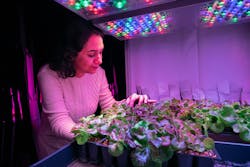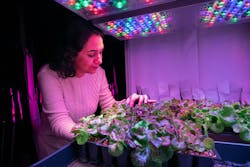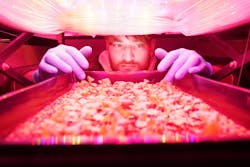New LED Strategies Could Make Vertical Farming More Productive
Purdue University researchers have designed two simple LED lighting strategies to increase yield and reduce energy costs for the vertical farming sector of indoor agriculture, according to a press release from Purdue Agricultural Communications.
The close-canopy and focused-lighting strategies developed by PhD candidate Fatemeh Sheibani and professor Cary Mitchell, both in the Department of Horticulture and Landscape Architecture in Purdue’s College of Agriculture, capitalize on LED lighting’s special properties.
“One is that they are relatively cool at the emitting surface, in contrast with other lighting choices,” Sheibani said in the release. Thus, the lighting system works closer to plants without scorching them. LEDs are also current driven, unlike many energy-intensive, voltage-driven lighting sources.
Their work is part of a project called OptimIA (Optimizing Indoor Agriculture). The project, led by Michigan State University, includes collaborators at Purdue, University of Arizona, and Ohio State University. OptimIA is sponsored by the U.S. Department of Agriculture's Specialty Crop Research Initiative.
LEDs are the lighting system of choice for indoor farming because of their relative energy efficiency and long lifetimes, Sheibani said. But improved LEDs also have high photon efficacy, meaning that electric energy is more readily converted to light that plants can use efficiently.
Still, inefficient capture of LED light reduces their benefits. Many indoor farmers, for instance, mistakenly believe that they can place their LEDs anywhere. But Sheibani and Mitchell noticed both in vertical farms and in smaller-scale experiments that the light fell not only on the plants but also on the walls and walkways. By reducing the distance between the LED system and the leaf canopy, the researchers were able to reduce such wasted light.
“We can improve canopy photon capture efficiency, as we call it, as long as we use LEDs correctly,” Sheibani said. “Canopy photon capture efficiency is the fraction of photons that reach the photosynthesizing machinery of the plants.”
Sheibani measures waste via a ratio of plant growth to LED electrical energy consumption. The resulting energy utilization efficiency compares grams of fresh or dry biomass yield per kilowatt hour of energy consumed by the LED lighting system.
“The higher the grams of fresh or dry biomass produced per kilowatt hour, the better it is,” she said. And both of Purdue’s tested scenarios found that the closest separation distance had the highest energy utilization efficiency.
Sheibani and Mitchell also are testing an energy-saving, focused-lighting approach that relies on a custom-made LED system with selective controls. The researchers want to answer the question of how small, individual, widely separated plants fare under slowly spreading beams of light rather than full coverage all the time?
“When seedlings emerge after germination, the very small plants are wide apart,” Mitchell said in the release. “It takes two weeks for them to grow together and close a canopy of baby greens. Everything in between is mostly wasted light until then.”
Sheibani and Mitchell’s system minimizes that waste. When plants are still small, they use full-coverage LED lighting inefficiently, Sheibani said. But it is possible to save energy in the earlier growth stages with focused lighting.
For more information on Sheibani and Mitchell's research, read the full release on Purdue University's website.


